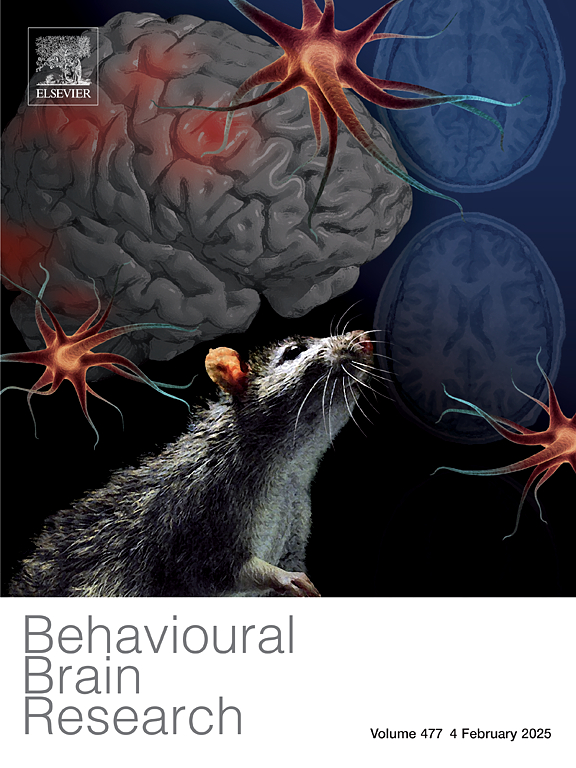青春期社会不稳定应激对雌雄大鼠社会奖励动机和多巴胺受体表达的影响
IF 2.6
3区 心理学
Q2 BEHAVIORAL SCIENCES
引用次数: 0
摘要
众所周知,青春期的社会经历会改变大脑和行为的持续发展。我们之前报道了青少年社会不稳定压力(SS;从出生后30-45天开始,每天1 (隔离和与新笼子伙伴配对)减少了雌性和雄性大鼠的社会互动。在这里,我们研究了青春期的SS是否降低了雌性和雄性Long-Evans大鼠的社会动机和改变了大脑中与社会奖励有关的区域的多巴胺受体mRNA的表达。当在青春期的社会操作性条件反射任务中,在一个门上戳鼻子可以获得社会刺激,而在另一个门上不可以,SS大鼠在训练期间比CTL大鼠进行更多的社会戳鼻子。在进行性比率测试(PRT)中需要增加努力时,SS大鼠与ctl没有差异;打开大门需要越来越多的鼻子戳;衡量社会动机)。然而,在成年期,SS和CTL大鼠在训练期间没有差异,尽管SS雌性大鼠在PRT上的社会动机降低。此外,雌性大鼠的社会动机高于雄性大鼠。无论测试年龄如何,SS大鼠的多巴胺受体亚型2 (D2)在两性和雌性大鼠的内侧前额叶皮层和伏隔核的mRNA表达增加,但多巴胺受体亚型1的mRNA表达没有增加。有证据表明,D2信号在这些大脑区域抑制社会行为,本研究表明,D2 mRNA表达的增加可能是SS大鼠明显的社会行为缺陷的基础。本文章由计算机程序翻译,如有差异,请以英文原文为准。
Effects of adolescent social instability stress on social reward motivation and dopamine receptor expression in female and male rats
Social experiences in adolescence are known to modify ongoing brain and behavioural development. We previously reported that adolescent social instability stress (SS; daily 1 h isolation and pairing with a new cage partner from postnatal days 30–45) reduced social interaction in female and male rats. Here, we investigated whether adolescent SS reduced social motivation and altered dopamine receptor mRNA expression in brain regions involved in social reward in female and male Long-Evans rats. When tested in a social operant conditioning task in adolescence whereby nose-pokes at one gate provided access to a social stimulus and at the other did not, SS rats made more social nose-pokes during training than did CTL rats. SS rats did not differ from CTLs when increased effort was required on the progressive ratio test (PRT; progressively more nose-pokes required to open gate; measure of social motivation). In adulthood, however, SS and CTL rats did not differ during training, although SS female rats had reduced social motivation on the PRT. Further, social motivation was higher in female than in male rats. Irrespective of age at testing, SS rats had increased dopamine receptor subtype 2 (D2), but not dopamine receptor subtype 1, mRNA expression in the medial prefrontal cortex in both sexes and in the nucleus accumbens in female rats. Given the evidence that D2 signaling in such brain regions inhibits social behaviour, the present research suggests that the increase in D2 mRNA expression may underlie the deficits in social behaviour evident in SS rats.
求助全文
通过发布文献求助,成功后即可免费获取论文全文。
去求助
来源期刊

Behavioural Brain Research
医学-行为科学
CiteScore
5.60
自引率
0.00%
发文量
383
审稿时长
61 days
期刊介绍:
Behavioural Brain Research is an international, interdisciplinary journal dedicated to the publication of articles in the field of behavioural neuroscience, broadly defined. Contributions from the entire range of disciplines that comprise the neurosciences, behavioural sciences or cognitive sciences are appropriate, as long as the goal is to delineate the neural mechanisms underlying behaviour. Thus, studies may range from neurophysiological, neuroanatomical, neurochemical or neuropharmacological analysis of brain-behaviour relations, including the use of molecular genetic or behavioural genetic approaches, to studies that involve the use of brain imaging techniques, to neuroethological studies. Reports of original research, of major methodological advances, or of novel conceptual approaches are all encouraged. The journal will also consider critical reviews on selected topics.
 求助内容:
求助内容: 应助结果提醒方式:
应助结果提醒方式:


